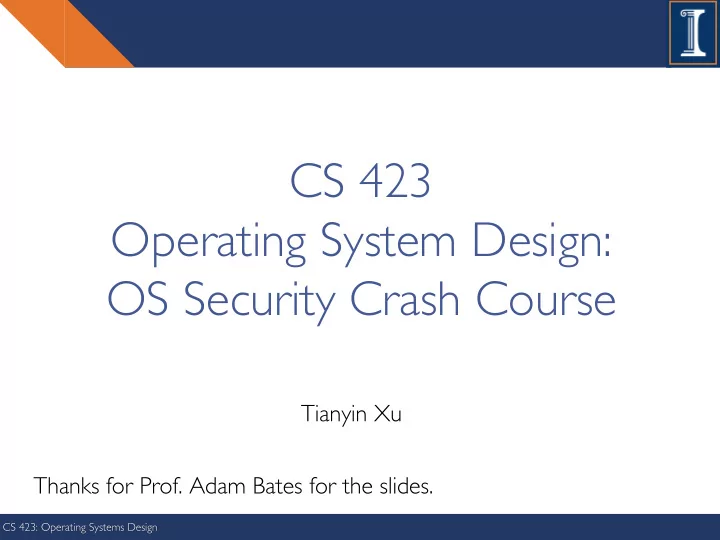

CS 423 Operating System Design: OS Security Crash Course Tianyin Xu Thanks for Prof. Adam Bates for the slides. CS 423: Operating Systems Design
Security Properties • Confidentiality? • Integrity? • Availability? • Authenticity? CS 423: Operating Systems Design 2
Security Properties • Confidentiality? • Only trusted parties can read data • Integrity? • Only trusted parties have modified data • Authenticity? • Data originates from the correct party • Availability? • Data is available to trusted parties when needed CS 423: Operating Systems Design 3
Security Functions Define security functions over principals (e.g., users, programs, sysadmins) • … and also entities (e.g., files, network sockets, ipc) • Authentication • How do we determine the identity of the principal? • Authorization • Which principals are permitted to take what actions on which objects? • Auditing • Record of (un) authorized actions that took place on the system for • post-hoc diagnostics CS 423: Operating Systems Design 4
Authorization • Access control matrix • For every protected resource, list of who is permitted to do what • Example: for each file/directory, a list of permissions • Owner, group, world: read, write, execute • Setuid: program run with permission of principal who installed it • Smartphone: list of permissions granted each app CS 423: Operating Systems Design 5
Question Access control matrices allow us to specify an arbitrary security policy … what properties should our security policy provide? CS 423: Operating Systems Design 6
Principle of Least Privilege • Grant each principal the least permission possible for them to do their assigned work • Minimize code running inside kernel • Minimize code running as sysadmin • Practical challenge: hard to know • what permissions are needed in advance • what permissions should be granted • Ex: to smartphone apps • Ex: to servers CS 423: Operating Systems Design 7
Authorization w/ Intermediaries • Trusted Computing Base (TCB) : set of software trusted to enforce security policy • Is it good or bad to have a large TCB? • Ex: Storage Server is trusted to check user access control list • Why? Because server must store/retrieve data on behalf of all users. • Implication? security flaw in server allows attacker to take control of system CS 423: Operating Systems Design 8
Encryption CS 423: Operating Systems Design 9
Authentication • How do we know user is who they say they are? • Try #1: user types password (something they know) • User needs to remember password! • Short passwords: easy to remember, easy to guess • Long passwords: hard to remember CS 423: Operating Systems Design 10
Question • Where are passwords stored? • Password is a per-user secret • In a file? • Anyone with sysadmin permission can read file • Encrypted in a file? • If gain access to file, can check passwords offline • If user reuses password, easy to check against other systems • Encrypted in a file with a random salt? • Hash password and salt before encryption, foils precomputed password table lookup CS 423: Operating Systems Design 11
Symmetric Key (DES, AES) CS 423: Operating Systems Design 12
Authentication • How do we know user is who they say they are? • Try #2: user has secret key • User needs to safely store the secret! • Is system configured s.t. it can protect the confidentiality of the secret key? • Can the user prove they know the secret without giving it to the other part? CS 423: Operating Systems Design 13
Public Key (RSA, PGP) CS 423: Operating Systems Design 14
Encryption Summary • Symmetric key encryption • Single key (symmetric) is shared between parties, kept secret from everyone else • Ciphertext = (M)^K • Public Key encryption • Keys come in pairs, public and private • Secret: (M)^K-public • Authentic: (M)^K-private CS 423: Operating Systems Design 15
2-Factor Authentication • Can be difficult for people to remember encryption keys and passwords • Instead, store private key (K-private) inside a chip Use PIN/PW to prove user is authorized (something user knows) • Use challenge-response to authenticate smartcard (something user has) • Are there other authentication factors? CS 423: Operating Systems Design 16
Public Key to Session Key • Public key encryption/decryption is slow; so can use public key to establish (shared) session key • assume both sides know each other’s public key CS 423: Operating Systems Design 17
Symmetric Key to Session Key • In symmetric key systems, how do we gain a session key with other side? • infeasible for everyone to share a secret with everyone else • solution: “authentication server” (Kerberos) • everyone shares (a separate) secret with server • server provides shared session key for A <-> B • everyone trusts authentication server • if compromise server, can do anything! CS 423: Operating Systems Design 18
Kerberos Example CS 423: Operating Systems Design 19
Message Digest (MD5, SHA) • Cryptographic checksum: message integrity • Typically small compared to message (MD5 128 bits) • “One-way”: infeasible to find two messages with same digest CS 423: Operating Systems Design 20
Cryptographic Hash Functions • What properties do we need? 1. Deterministic 2. Quick 3. One-Way 4. “Avalance Effect” 5. Collision Resistant 6. Pre-image attack resistant • How does this compare to non-crypto hashes? All of these functions were once thought to be cryptographically strong (some are not)… Seahash outperforms BLAKE(2) by 32x! CS 423: Operating Systems Design 21
Security Practice • In practice, systems are not that secure • hackers can go after weakest link • any system with bugs is vulnerable • vulnerability often not anticipated • usually not a brute force attack against encryption system • often can’t tell if system is compromised • hackers can hide their tracks • can be hard to resecure systems after a breakin • hackers can leave unknown backdoors CS 423: Operating Systems Design 22
Recommend
More recommend